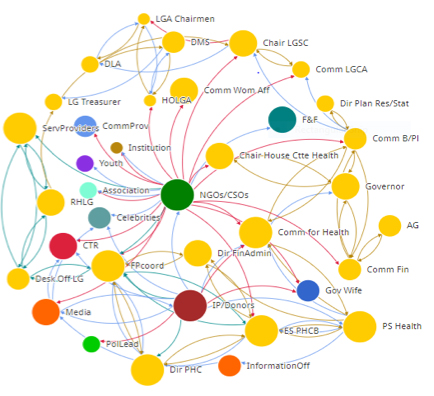Author: Jarret Cassaniti, Johns Hopkins Center for Communication Programs
Problem and context:
The Challenge Initiative (TCI) is a demand-driven incentive for financing, scaling up and sustaining high-impact family planning solutions for the urban poor. Local governments self-select to participate and demonstrate political commitment by providing their own financial, material and human resources. In return, TCI brings technical expertise as well as support from its Challenge Fund.
Learning question:
In February 2018 TCI in Nigeria sought to identify influential and well-connected stakeholders to engage with in family planning work in Ogun State. In particular, they wanted to further understand the key family planning influencers in key states, therefore allowing for a refocus of advocacy efforts based on knowledge of the roles of each stakeholder, what they influence, level of influence, and flow of influence.
Recognizing that there was a wealth of knowledge that already existed among TCI’s community of advocacy professionals, the team aimed to harness each individual’s tacit knowledge on the family planning landscape and turn it into group knowledge.
How did the program harness responsive feedback?
Net‐Map was used by TCI to rapidly seek and receive feedback on the current family planning context in Ogun State, Nigeria. Net-Map is a visual social networking analysis, created through a facilitated discussion.[1] The tool was used to gather a variety of viewpoints about who influences FP uptake and respond to the feedback by proposing, in real time, activities to engage the key influencers that were identified.
The Net-Map process enabled the TCI team to quickly but deliberately turn tacit and implicit knowledge held by 30 family planning advocates in Ogun state into explicit knowledge. Within two days, they had identified formal and informal networks, spoken about bottlenecks, and reasons for the success and failure of previous efforts at improving the contraceptive prevalence rate.
The merits of Net-Map
Net-Map satisfies research interest and immediate stakeholder needs. As a flexible and interactive process, it can be used to increase productivity as well as reduce lengthy analysis and its associated costs. At the same time, because of its theoretical underpinnings in social networks analysis and participatory action research, Net-Map offers a reliable and quantifiable methodology for analyzing and evaluating influence, which can be validated and supported through digitization.
Crucially, it provides data that may not be gleaned from key informant interviews and focus groups since it is a hand‐on and visual activity that explores people’s roles in a network.
Outcomes
The process resulted in the map below, validating the role that NGO’s play, but revealing an influential, and well‐connected stakeholder that had largely been ignored in project planning: the governor’s wife.
Also, the net mapping identified the critical role and importance of the media and religious leaders in family planning advocacy efforts in all geographies. Following this, the media and religious leaders now engage with policy makers on their FP roles.

Net-Map produced by family planning advocates
Advice on how to run the Net-Map process:
Find an appropriate definition of influence that everyone agrees upon. In different cultural and political contexts, you might have to use different terminology. Agreeing on a definition and/or terminology is especially important, since power and influence are sensitive issues in many contexts.
After setting up the influence towers, encourage participants to verbalize what they see, starting with the highest tower.
Once the group is content with the whole set-up, note the height of the influence towers in marker next to the actors’ names on the network map.
Go through all the actors on your map and keep in mind that it is crucial to understand not only why the powerful are powerful, but also why others are seen as having no influence.
Key learnings about responsive feedback:
- Create the right environment for valuable insights to be shared
Insights from on-the-ground staff and stakeholders can be game-changing. Yet, the formal environments of traditional interviews and focus groups may not unlock these. Knowledge can flow better in participatory processes when people are moving around and having fun – rather than stuck to a chair.
- Accessible data gathering methods enable frequent feedback loops
Net-Map is an accessible method of data collection and analysis. This increases the likelihood that it will be repeated frequently, and therefore the regularity with which program impacts will be mapped, evaluated, and adaptively managed.
[1] Developed by Eva Schiffer